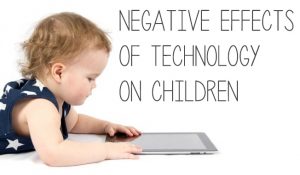Negative Effects of Technology on Children
 In today’s society, it’s more common to find an electronic device in a home than it is an old fashioned book. In fact, new studies show that the average child in the U.S. spends about 7.4 hours per day looking at a screen, otherwise known as “screen time”. Like many other parents out there, you are probably wondering if you should have concerns about your child and the amount of time they spend with technology. Is my child spending too much time on electronic devices? Can device screens impact my child’s vision? Questions like these are currently being researched. Let’s see what science has to say.
In today’s society, it’s more common to find an electronic device in a home than it is an old fashioned book. In fact, new studies show that the average child in the U.S. spends about 7.4 hours per day looking at a screen, otherwise known as “screen time”. Like many other parents out there, you are probably wondering if you should have concerns about your child and the amount of time they spend with technology. Is my child spending too much time on electronic devices? Can device screens impact my child’s vision? Questions like these are currently being researched. Let’s see what science has to say.
Eye Strain vs. Damage
When discussing the effects of computer screens on vision, it is important to define what constitutes damage. Optometrists and ophthalmologists differentiate between eye strain and eye damage. Eye strain is simply fatigue. Your eyes can get worn out after doing the same thing for many hours. Eye strain due to staring at a screen is so common that it has its own name — computer vision syndrome (CVS). (Ha, and I thought that just referenced a pharmacy chain!)
Your eyes will recover easily from fatigue with just a little rest, but it is possible for screens to cause permanent damage. This damage comes in the form of an increased risk of short-sightedness (myopia). Myopia secondary to too much screen time is a bigger risk factor for children and teens whose eyes are still developing. Basically, if your child’s nose is practically glued to their device, it might not hurt to have them checked out.
Computer Vision Syndrome (CVS)
Computer vision syndrome refers to symptoms like dry, itchy, watery eyes and headache that arise from too much screen time. The dryness is caused by the fact that you blink less while looking at a screen. People blink an average of 18 times per minute under normal circumstances, which refreshes the eyes and keeps them lubricated with tears. When staring at a screen, blink rates drop to just a few times per minute. The headache that is associated with CVS is a result of the muscles in the eyes working to keep the screen you are staring at in focus. It's no different from any other tension headache that can arise from reading too much or working on a vision-intensive hobby.
To reduce the impact of CVS, you can make a few simple changes. Start by keeping your device or monitor at the lowest angle possible relative to your eyes. You want to be looking down on whatever you are doing to reduce both neck and eye strain, and this can also promote more frequent blinking. You should also take regular breaks to allow your eyes to rest and refresh themselves. Frequent breaks will also reduce the chance of headache or migraine.
*Tip: Try setting a timer away from your child. Have it go off several times an hour so that your child must dislodge their corneas from their device in order to turn the alarm off. This will give their eyes a rest, and give your child a short break as they will suddenly realize they have to either eat, use the restroom, or complete a chore that would ensure the continued use of said device.
Myopia
It isn't just myopia that children need to worry about if they spend too much time staring at a screen, but rather progressive myopia. Progressive myopia means that near-sightedness worsens over time. This is a particular risk for children who already suffer from myopia or who have parents affected by near-sightedness.
To reduce the risk of myopia in children, they should follow all of the tips above for reducing eye strain and they should limit their screen time. Professionals recommend that children follow the 20-20-10 rule, which means that they look away from the screen every 20 minutes and focus on an object that is at least 20 feet away for no less than 10 seconds. This simple exercise helps to relax eye muscles and reduce the kind of fatigue that could lead to progressive myopia.
Monitoring
No matter what your child's age, it is important that he or she be monitored for vision problems. Yearly eye exams are a great way to catch problems early, before they lead to permanent damage.
Beyond that, encourage your children to spend more time outdoors and try to balance school work so that it includes screen time as well as more traditional learning activities. Though it can be so much easier just to let them disappear in the virtual world, sooner or later reality will come-a-knocking!


